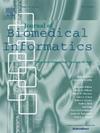利用原型学习揭示肾小球病变识别的病理相关预测不确定性。
IF 4
2区 医学
Q2 COMPUTER SCIENCE, INTERDISCIPLINARY APPLICATIONS
引用次数: 0
摘要
目的:鉴别肾小球病变对慢性肾脏病的诊断至关重要。然而,由于病变的异质性、叠加性、进展性和组织的不完全性,深度学习面临着挑战,导致模型预测的不确定性。因此,分析肾小球病变识别中病理相关的预测不确定性,揭示其与病理性质的关系及其对模型性能的影响至关重要。方法:提出基于原型学习的肾小球病变预测不确定性估计、病理特征相关性分析和权重重分布预测校正的病理相关预测不确定性分析框架。基于原型学习的预测不确定性估计包括深度原型、亲和嵌入和多维不确定性融合。病理特征相关分析是首次使用基于专家和基于学习的方法来构建病变和组织的病理相关特征。权重重分配预测校正模块执行基于权重重的病灶识别。结果:为了验证其性能,进行了大量的实验。基于Spearman和Pearson相关性分析,本文提出的框架能够实现更高效的相关性分析,并与病理相关表征具有较强的相关性(c index > 0.6和p )。结论:本文提出的肾小球病变识别预测不确定性分析,为从病理相关角度评估计算病理学的预测不确定性提供了一种有价值的方法。意义:为算法开发和临床实践中与病理相关的预测不确定性估计提供了解决方案。本文章由计算机程序翻译,如有差异,请以英文原文为准。

Unveiling pathology-related predictive uncertainty of glomerular lesion recognition using prototype learning
Objective
Recognizing glomerular lesions is essential in diagnosing chronic kidney disease. However, deep learning faces challenges due to the lesion heterogeneity, superposition, progression, and tissue incompleteness, leading to uncertainty in model predictions. Therefore, it is crucial to analyze pathology-related predictive uncertainty in glomerular lesion recognition and unveil its relationship with pathological properties and its impact on model performance.
Methods
This paper presents a novel framework for pathology-related predictive uncertainty analysis towards glomerular lesion recognition, including prototype learning based predictive uncertainty estimation, pathology-characterized correlation analysis and weight-redistributed prediction rectification. The prototype learning based predictive uncertainty estimation includes deep prototyping, affinity embedding, and multi-dimensional uncertainty fusion. The pathology-characterized correlation analysis is the first to use expert-based and learning- based approach to construct the pathology-related characterization of lesions and tissues. The weight-redistributed prediction rectification module performs reweighting- based lesion recognition.
Results
To validate the performance, extensive experiments were conducted. Based on the Spearman and Pearson correlation analysis, the proposed framework enables more efficient correlation analysis, and strong correlation with pathology-related characterization can be achieved (c index > 0.6 and p < 0.01). Furthermore, the prediction rectification module demonstrated improved lesion recognition performance across most metrics, with enhancements of up to 6.36 %.
Conclusion
The proposed predictive uncertainty analysis in glomerular lesion recognition offers a valuable approach for assessing computational pathology’s predictive uncertainty from a pathology-related perspective.
Significance
The paper provides a solution for pathology-related predictive uncertainty estimation in algorithm development and clinical practice.
求助全文
通过发布文献求助,成功后即可免费获取论文全文。
去求助
来源期刊

Journal of Biomedical Informatics
医学-计算机:跨学科应用
CiteScore
8.90
自引率
6.70%
发文量
243
审稿时长
32 days
期刊介绍:
The Journal of Biomedical Informatics reflects a commitment to high-quality original research papers, reviews, and commentaries in the area of biomedical informatics methodology. Although we publish articles motivated by applications in the biomedical sciences (for example, clinical medicine, health care, population health, and translational bioinformatics), the journal emphasizes reports of new methodologies and techniques that have general applicability and that form the basis for the evolving science of biomedical informatics. Articles on medical devices; evaluations of implemented systems (including clinical trials of information technologies); or papers that provide insight into a biological process, a specific disease, or treatment options would generally be more suitable for publication in other venues. Papers on applications of signal processing and image analysis are often more suitable for biomedical engineering journals or other informatics journals, although we do publish papers that emphasize the information management and knowledge representation/modeling issues that arise in the storage and use of biological signals and images. System descriptions are welcome if they illustrate and substantiate the underlying methodology that is the principal focus of the report and an effort is made to address the generalizability and/or range of application of that methodology. Note also that, given the international nature of JBI, papers that deal with specific languages other than English, or with country-specific health systems or approaches, are acceptable for JBI only if they offer generalizable lessons that are relevant to the broad JBI readership, regardless of their country, language, culture, or health system.
 求助内容:
求助内容: 应助结果提醒方式:
应助结果提醒方式:


